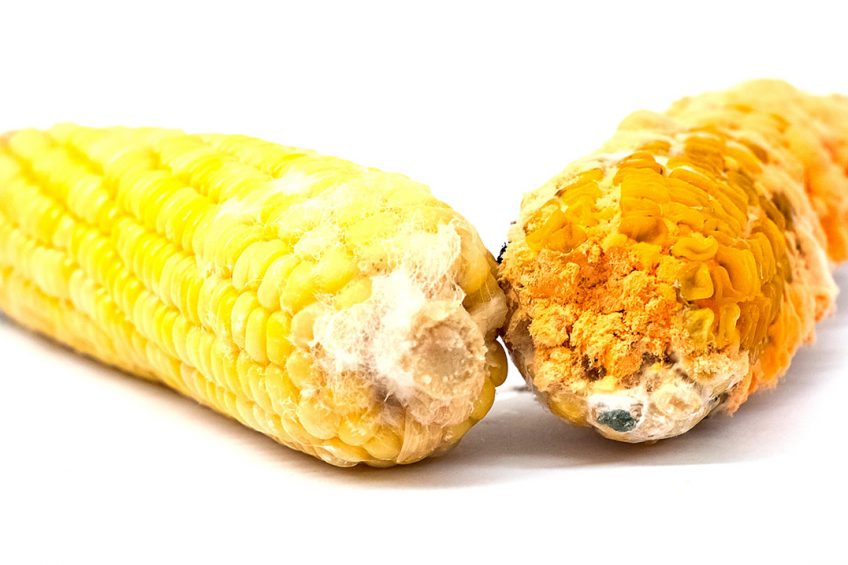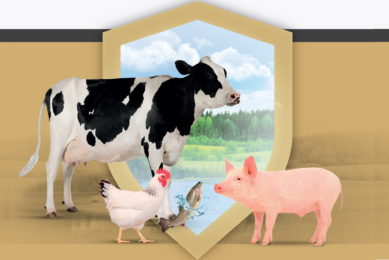Mitigating in-feed mycotoxins with yeast

The impact of in-feed mycotoxins on farm animal health and performance continues to be a major management and mitigation challenge for livestock producers and animal feed manufacturers. Yeast’s ability to bind mycotoxins is an effective solution to minimise the damage.
While global crop production standards are obviously designed to address the control and reduction of mycotoxin levels at source, current data suggests that, far from being a diminishing problem, the contamination of feed rations remains worryingly high. Survey evidence, gathered within the last five years, indicates that more than 70% of feed and feed raw material sampled, revealed the presence of at least one mycotoxin. Other studies suggest that significant multi-contamination levels exist in mycotoxin mixtures. There’s also evidence that climate change is causing mycotoxin levels in some crops to increase, a development which is raising new concerns. According to research carried out by Battilani et al. in 2016, for example, Aflatoxin B1 contamination in maize in Europe showed increases due to climate change factors.
Reducing impacts of mycotoxin exposure
Given the continuing difficulty of controlling mycotoxins at source, therefore, the focus of attention among farmers, feed suppliers and feed additive specialists, is increasingly turning to the development of effective binding agents and biotransforming agents, both of which appear to have the potential of reducing the adverse impact on animal health and performance of mycotoxin exposure. Left unchecked, we know that the many and varied mycotoxins to which cattle, sheep, horses, pigs and poultry are exposed, are capable of causing serious health issues, even resulting in the death of badly affected animals in some cases. In addition, even when the exposed animal survives, there are many examples of depressed growth, loss of appetite, poor productive performance and reduced levels of immunity.
Cows and pigs
In dairy cows, for example, we see mycotoxins being linked to an increased incidence of irregular heats, low conception rates, embryonic loss and abortions. Cows also suffer depressed production and performance issues, alongside an increase in susceptibility to infectious diseases. Similar problems have been observed in pigs, with evidence of the presence of mycotoxins in feed being linked to poor gut integrity, diarrhoea, inflammation of the bladder and kidney, decreased performance and suppressed immunity.
Impact studies for sheep, horses and poultry, tell a similar story, linking mycotoxins to depressed performance, poor reproductive efficiency and immunosuppression problems
Furthermore, detailed analysis of the impact of mycotoxins on growing pigs, carried out by Andretta et al. in 2016 and based on results drawn from 13,000 animals, revealed that the presence of an individual mycotoxin could be linked to a 14% reduction in feed intake, on average, and a 17% reduction in weight gain. In addition, when a combined set of mycotoxins was present, the same analysis revealed a reduction in feed intake of 42% and weight gain reduction of 45%. Impact studies for sheep, horses and poultry, tell a similar story, linking mycotoxins to depressed performance, poor reproductive efficiency and immunosuppression problems.
The benefits of binding
The role of binding agents and biotransforming agents and their potential use in combating such impacts, is well understood by toxicology specialists and largely appreciated by the animal feed industry. To explain in brief, therefore, binding agents bind the mycotoxins present in contaminated feed, thus limiting their bioavailability after ingestion and decreasing the exposure of animals to in-feed mycotoxins. Biotransforming agents, meanwhile, degrade or transform in-feed mycotoxins into a less toxic, or even non-toxic, metabolites.
Safwall 3B Integrated Strategy
Understanding, and accepting, the potential of binding and biotransforming solutions is one thing, of course. Identifying and scientifically proving individual products and processes that are effective and reliable against mycotoxins, is quite another. In line with the 30 years of research and development commitment at Phileo by Lesaffre, designed to deliver animal health and performance solutions based on live yeasts, bacteria and yeast products, the company’s focus on helping to mitigate the impact of mycotoxins on farm livestock, centres on the Safwall 3B Integrated Strategy.
Biosorption, Barrier integrity and Body protection
Safwall is a yeast cell wall (YCW) supplement which binds to mycotoxins to reduce damaging absorption by at-risk animals, protecting their intestines and organs from the potentially devastating impact of in-feed mycotoxins. The term 3B Integrated Strategy, meanwhile, stands for Biosorption, Barrier integrity and Body protection. Using adsorption isotherms to select the best binder from a wide range of YCWs, Safwall has been exposed to numerous trials concerning the most common mycotoxins (Fusarium species), such as trichothecenes, fumonisins, and zearalenone. Results from these trials have duly shown the effectiveness of the product in reducing mycotoxin absorption, with an equivalent lowering of related toxic effect on in-trial animals. The use of Safwall, for example, when added to feed for chicken as a protective binder against zearalenone (ZEA), showed an effective decrease in plasma ZEA concentration, especially at the highest dosage level (see Figure 1).

Extra protection for the animal
Trial results also show that the intestinal barrier function is improved in animals fed Safwall, reducing the intestinal impermeability caused by Fusarium mycotoxins, and protecting the animal from increased translocation of luminal antigens. This includes such factors as commensal flora, pathogens, food antigens and toxins/mycotoxins and, consequently, reduces the incidence of infectious diseases. The beneficial impact of the product on health and performance issues is clearly a major positive in relation to combating the threat of Fusarium mycotoxins. Strong trial results have been gained concerning the product’s use in connection with health, growth and reproductive issues in dairy cows, poultry and pigs (see Figure 2).

Mycotoxins: a big family
At the same time, it’s important to acknowledge that the single word ‘mycotoxins’ represents a big family. As an industry, we all know a lot about aflatoxins, ochratoxin A, fumonisins, trichothecenes (DON, T2 toxin, etc.), zearalenone and ergot, each of which is regulated, or subject to maximum limits, concerning their presence in commodities, feed and/or food. There are also other mycotoxins, however, which are less well known, and which are currently not covered by appropriate regulation. While all companies, Phileo by Lesaffre and others, continue to advance the knowledge, control and mitigation of mycotoxins, there is clearly a need to increase the industry’s drive to combat the issues about which more knowledge is required.
Author: Dr Virginie Marquis, R&D manager for Toxicology, Phileo by Lesaffre






